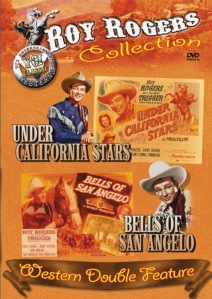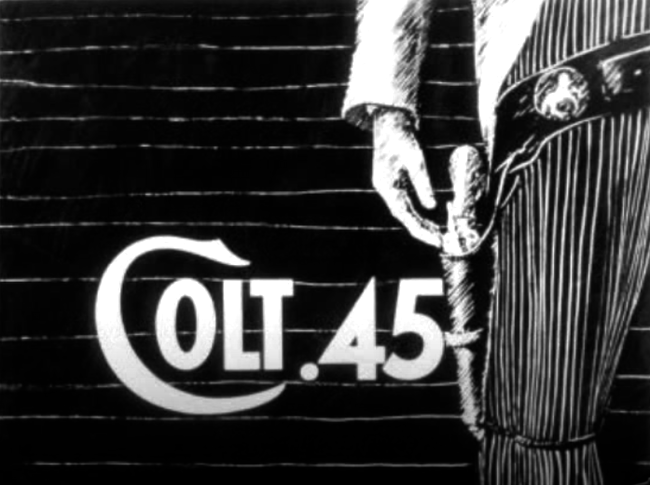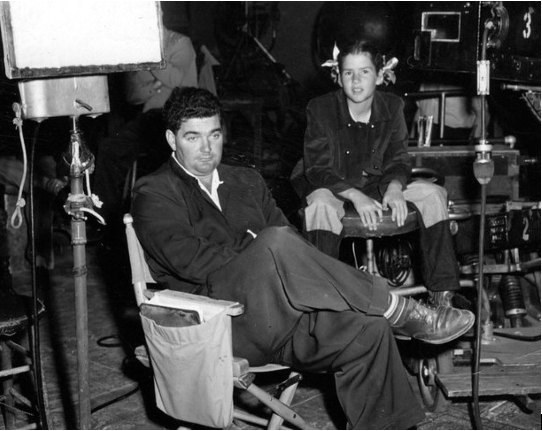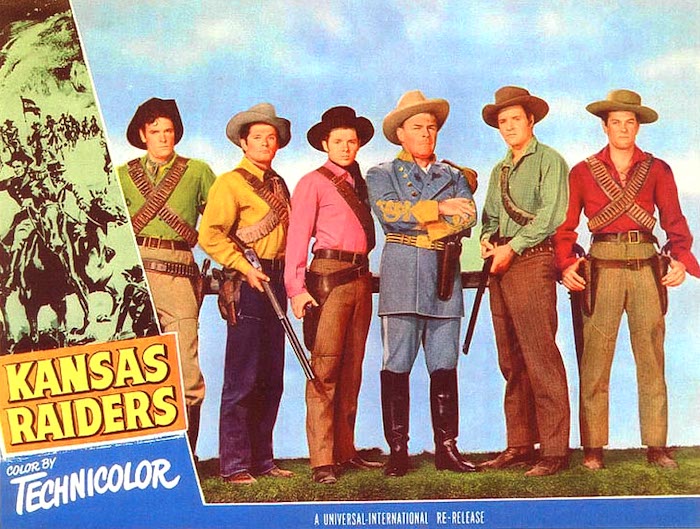Directed by Anthony Mann
Starring Robert Taylor, Louis Calhern, Paula Raymond, Marshall Thompson, James Mitchell, Edgar Buchanan
One of John Alton’s pictures making its way to Blu-Ray is a reason to celebrate — so get out the champagne, here comes Devil’s Doorway (1950) from Warner Archive.*
This Anthony Mann picture — one of the first of what we’d come to label “50s Westerns” — is terrific in every possible way. Robert Taylor is great as the Indian who returns home from the Civil War with a Medal Of Honor, only to find the typical respectable townspeople (Louis Calhern is one of ’em) trying to take away his father’s land. It’s short, tight, tense — all the usual Mann stuff.
For somebody you’d never really think of as a Western actor, Robert Taylor sure made some great ones: this one, Westward The Women (1951), The Last Hunt (1956), The Law And Jake Wade (1958), etc. Devil’s Doorway one comes highly, highly recommended.
* I’d like to think that Blu-Ray technology was developed just so us movie nuts could better watch the work of cats like William Clothier, Gregg Toland, Stanley Cortez and, of course, John Alton.
Archive for the ‘1950’ Category
Blu-Ray News #372: Devil’s Doorway (1950).
Posted in 1950, Anthony Mann, DVD/Blu-Ray News, Edgar Buchanan, John Alton, MGM, Robert Taylor, Warner Archive on March 30, 2024| 8 Comments »
DVD Review: Lightning Guns (1950).
Posted in 1950, Charles Starrett, Columbia, Critics' Choice, DVD/Blu-Ray Reviews, Fred F. Sears, Jock Mahoney, Mill Creek Entertainment, Ray Nazarro, Smiley Burnette, The Durango Kid on March 4, 2024| Leave a Comment »
Directed by Fred F. Sears
Produced by Colbert Clark
Screen Play by Victor Arthur
Based on a story by Bill Milligan
Director Of Photography: Fayte M. Browne
Film Editor: Paul Borofsky
Music by Mischa Bakaleinikoff
Cast: Charles Starrett (Steve Brandon/Durango Kid), Smiley Burnette (Smiley), Gloria Henry (Susan Atkins), William Bailey (Luke Atkins), Edgar Dearing (Capt. Dan Saunders), Raymond Bond (Jud Norton), Jock O’Mahoney (Sheriff Rob Saunders)
Pulled out Mill Creek’s two-disc The Durango Kid Collection again the other day. This time, it was Lightning Guns (1950).
Ranchers in Piute Valley are fighting over water and the building of a dam, and Steve Brandon (Charles Starrett) and Smiley ride right in the middle of it all. A local banker, who was going to approve a loan to get the dam built, is murdered and soon sheriff Jock O’Mahoney has to arrest his own father.
Steve and Smiley (and Durango) sort it out, revealing that the local grocer is the murderer. There’s a lot of riding and shooting, and a cool thread involving a rare .41 caliber pistol — and Smiley is a traveling bathtub salesman, logging a heavy tub from scene to scene.
Gloria Henry did Lightning Guns between a couple of key Western pictures — Strawberry Roan (1948) with Gene Autry and Fritz Lang’s Rancho Notorious (1952). Jock Mahoney (billed here as O’Mahoney) had been doubling for Charles Starrett on the series and was making the transition to actor. He acted in a number of the later ones.
The Durango Kid is cool, but he never really seems to fit in his own films. For one thing, it’s hard to fathom how Starrett can travel from town with two horses (Steve’s Bullet and Durango’s Raider) without getting found out. I loved these films as a kid, but always wondered how he pulled it all off.
 Fred F. Sears worked as a character actor and dialogue director on the series before climbing into the director’s chair. Here, he keeps things moving at a quick pace and handles Smiley Burnette’s comedic scenes well. Smiley’s stuff seems a bit intrusive (or tacked on) in some of these pictures.
Fred F. Sears worked as a character actor and dialogue director on the series before climbing into the director’s chair. Here, he keeps things moving at a quick pace and handles Smiley Burnette’s comedic scenes well. Smiley’s stuff seems a bit intrusive (or tacked on) in some of these pictures.
From 1945 to 1952, Columbia, Starrett, Smiley and crew (including directors Sears and Ray Navarro) worked at a frantic pace, making a total of 64 Durango Kid pictures. Lightning Guns is one of the 10 movies in Mill Creek’s budget-friendly set, The Durango Kid Collection. The transfer looks wonderful. It’s a nice little set, and it comes highly recommended. (Wish they’d get around to a volume two!)
 Mill Creek has come through with some terrific multi-picture sets over the last few years. They’re often made up of Columbia pictures — with sets dedicated to William Castle, The Whistler, Jungle Jim, Randolph Scott, Hammer Films and more. (Some are released through Critic’s Choice.) Many of the titles have been available singly or as MOD releases, but the prices can’t be beat, and they’ll save you space as we watch our collections gobble up our real estate.
Mill Creek has come through with some terrific multi-picture sets over the last few years. They’re often made up of Columbia pictures — with sets dedicated to William Castle, The Whistler, Jungle Jim, Randolph Scott, Hammer Films and more. (Some are released through Critic’s Choice.) Many of the titles have been available singly or as MOD releases, but the prices can’t be beat, and they’ll save you space as we watch our collections gobble up our real estate.
Blu-Ray News #369: Colt .45, The Complete Series (1957-1960)
Posted in 1950, 1957, 1958, 1959, Edwin L. Marin, George Waggner, Lew Landers, Oliver Drake, Paul Landres, Randolph Scott, Television, Warner Archive, Warner Bros. on January 22, 2024| 1 Comment »
Warner Archive has announced a Blu-Ray set of the complete Colt .45 TV series. One of Warner Brothers’ Western shows of the 50s, airing on ABC from October ’57 to September 1960, it’s been hard to see for quite a while.
Loosely based on the 1950 Randolph Scott movie directed by Edwin L. Marin, the series has 67 half-hour episodes. It originally starred Wayde Preston as Christopher Colt. Preston left the shows and was replaced by Donald May as Preston’s cousin Sam Colt. Wayde Preston eventually returned, but he was made a minor character. The directors include Edward Bernds, George Waggner, Oliver Drake, Paul Landres and Lew Landers.
Warner Archive has restored all 67 episodes from their camera negatives, so this should be a real treat. It’s exciting to think what might follow from the WB TV archives. Coming in February.
Happy Birthday, William Witney.
Posted in 1950, Republic Pictures, Roy Rogers, William Witney on May 15, 2023| 1 Comment »
William Witney
(May 15, 1915 – March 17, 2002)
William Witney was born 108 years ago. He was a true innovator in how action makes its way to the movie screen. He was working at Republic Pictures, and while on location for the 1937 serial The Painted Stallion, the director, Ray Taylor, was too drunk to work. Witney took over at just 21.
Watching Busby Berkeley put together one of his famous dance numbers, Witney realized that fight sequences could be choreographed and shot the same way. He under-cranked the camera to speed up the action — merely fast became death-defying. He experimented with the best place to put the camera car when tracking a chase — along the side of the car or stagecoach vs. shooting head-on, with horses charging straight at the camera.
After serving in a Marine combat camera unit in World War II, Witney returned to Republic for his last serial, The Crimson Ghost (1946), then took over the Roy Rogers movies. Dialing up the action, putting less emphasis on the music and bringing in a decidedly darker, more violent tone, Witney breathed new life into Roy’s final films.
William Witney was a genius, and his contribution the cinema has been pathetically under-appreciated.
Photo up top: William Witney and Cheryl Rogers on the set of Trail Of Robin Hood (1950). Photo courtesy of Jay Dee Witney.
Blu-Ray News #355: Audie Murphy Collection II (1950-1954).
Posted in 1950, 1954, Audie Murphy, Brian Donlevy, DVD/Blu-Ray News, Edgar Buchanan, George Marshall, I. Stanford Jolley, James Arness, John Doucette, Kino Lorber, Lyle Bettger, Mari Blanchard, Ray Enright, Scott Brady, Tony Curtis, Universal (International), Wallace Ford, Wanda Hendrix on March 29, 2023| 27 Comments »
Kino Lorber’s second hi-def batch of Audie Murphy Westerns is coming in June. This set includes Sierra (1950), Kansas Raiders (1950) and Destry (1954).
Sierra (1950)
Directed by Alfred E. Green
Starring Wanda Hendrix, Audie Murphy, Burl Ives, Dean Jagger, Tony Curtis, James Arness, Jack Ingram, Houseley Stevenson, I. Stanford Jolley
Audie and his dad, Dean Jagger, have been hiding in the mountain for years. A chance meeting with Wanda Hendrix brings civilization to their doorstep, where it’s not welcome.
Wanda Hendrix and Audie Murphy were newlyweds when production began on this one. They were separated before its release. Some really nice horse stuff (some of it lifted from 1949’s Red Canyon) and a great cast of character actors.
I’m doing a commentary for this one.
Kansas Raiders (1950)
Directed by Ray Enright
Starring Audie Murphy, Brian Donlevy, Marguerite Chapman, Scott Brady, Tony Curtis, Richard Arlen, Richard Long
U-I mangles history again, but who cares? Murphy is Jesse James, Brian Donlevy is Quantrill. Yet another solid Western from Ray Enright, with typically-gorgeous cinematography from Irving Glassberg.
Destry (1954)
Directed by George Marshall
Starring Audie Murphy, Mari Blanchard, Lyle Bettger, Thomas Mitchell, Edgar Buchanan, Lori Nelson, Wallace Ford
For this 1954 remake, U-I puts Murphy and Mari Blanchard in the roles played by James Stewart and Marlene Dietrich in 1939’s Destry Rides Again. George Marshall directed both versions. (There was a semi-remake in 1950, Frenchie, with Joel McCrea, Shelley Winters and Marie Windsor.) In this one, it’s good to see Murphy play against type a bit, and it’s always great to see Wallace Ford. Of course, Mari Blanchard looks terrific.
All three of these pictures boast the usual U-I 50s Western Technicolor sheen. (Destry should be widescreen.) They’ll look wonderful on Blu-Ray. Highly recommended.
“Hello, Folks…”
Posted in 1950, Ads, posters & art, Jacques Tourneur, Joel McCrea, MGM on March 8, 2023| 11 Comments »
The Exhibitor, 1950.
Posted in 1950, Charles Starrett, Gene Autry, George "Gabby" Hayes, Hopalong Cassidy, Randolph Scott, Roy Rogers, The Durango Kid, Tim Holt, William Boyd on February 17, 2023| 3 Comments »
We looked at Exhibitor magazine’s top cowboy stars for 1951 a while back. Here’s the 1950 list.
By the way, this was the year that Gabby Hayes left theaters with the Randolph Scott picture The Caribou Trail.
A Night At The Movies, 1950.
Posted in 1950, A Night At The Movies, Edwin L. Marin, Lloyd Bridges, Randolph Scott, Ruth Roman, Warner Bros., Zachary Scott on March 18, 2021| 20 Comments »
Roy Rogers And Trucolor And DVD And Blu-Ray (Updated).
Posted in 1950, Dale Evans, DVD reviews, releases, TV, etc., Kino Lorber, Olive Films, Penny Edwards, Pre-1950, Republic Pictures, Roy Rogers, VCI Entetainment, William Witney on February 11, 2021| 70 Comments »
THIS IS AN UPDATE OF A POST FROM JULY OF 2012. It continues to be a really popular post, and it seemed due for a refresh. This will be further updated as time goes on.
Henry Cabot Beck of True West Magazine and I were emailing back and forth about the color Roy Rogers pictures (Trucolor, to be precise), how wonderful they are, and how terribly they’re represented on DVD. It’s a matter that has been beaten to death on a number of newsgroups, which shows just how important this really is. With these pictures in mind, a hastily-constructed post seemed in order.
The official releases worth your time and money are (where appropriate, clicking on the art will take you to a seller):
DVD
 Bells Of Coronado (1950) is the only Roy Rogers picture Lions Gate got around to putting out on DVD during their handling of the Republic Pictures catalog. Unfortunately, Olive Films’ time with the Republic titles didn’t result in a single Rogers disc.
Bells Of Coronado (1950) is the only Roy Rogers picture Lions Gate got around to putting out on DVD during their handling of the Republic Pictures catalog. Unfortunately, Olive Films’ time with the Republic titles didn’t result in a single Rogers disc.
Bells Of Coronado is a good one, with Dale Evans, Trigger, Grant Withers and Pat Brady adding their usual support. William Witney lends his masterful direction, the songs are great and the Trucolor looks good. I think this is out of print, but it’s still listed here.
 VCI’s Roy Rogers Western Double Feature Volume 1 presents Under California Stars (1948) and The Bells of San Angelo (1947) — both uncut and both looking just fine. California features Jane Frazee and Andy Devine, while San Angelo has Dale Evans, Andy Devine and Bob Nolan and the Sons of the Pioneers. Witney directed both. It’s also a deal, available through their website for just four bucks! Trailers are even included. So mosey on over and pick one up.
VCI’s Roy Rogers Western Double Feature Volume 1 presents Under California Stars (1948) and The Bells of San Angelo (1947) — both uncut and both looking just fine. California features Jane Frazee and Andy Devine, while San Angelo has Dale Evans, Andy Devine and Bob Nolan and the Sons of the Pioneers. Witney directed both. It’s also a deal, available through their website for just four bucks! Trailers are even included. So mosey on over and pick one up.
 Springtime In The Sierras (1947) came out from Film Chest (in 2016) and The Film Detective, transferred from a complete 16mm print. It might be a bit soft, but it’s a good one and it’s complete.
Springtime In The Sierras (1947) came out from Film Chest (in 2016) and The Film Detective, transferred from a complete 16mm print. It might be a bit soft, but it’s a good one and it’s complete.
BLU-RAY
Kino Lorber took over from Olive Films and released some nice stuff, including a couple of color Rogers films, from restored materials. They’re available on both Blu-Ray and DVD, and both feature commentaries from some Bozo named Toby Roan. They’re absolutely beautiful.
Sunset In The West (1950) looks incredible. It’s got Penny Edwards instead of Dale Evans, and there’s terrific support from Gordon Jones, Will Wright and Paul E. Burns. The climax, with Trigger chasing down a locomotive, has some really amazing stuntwork.
Trigger Jr. (1950) has Dale Evans, Pat Brady, Gordon Jones, Grant Withers and Foy Willing And The Riders Of The Purple Sage. It really focuses on Trigger, so there’s a lot of great horse stuff in it.
I wish this was a lot longer post, with the rest of the color Rogers pictures listed. But at this time, Paramount owns the rights and no one has licensed anything. Maybe someday.
Till then, “may the good Lord take a liking to you.”
Dakota Lil (1950) — The Marie Windsor Blogathon By Guest Blogger Boyd Cathey.
Posted in 1950, 20th Century-Fox, George Montgomery, Lesley Selander, Marie Windsor, Rod Cameron, Wallace Ford on December 11, 2020| 7 Comments »
Directed by Lesley Selander
Produced by Jack Jungmeyer
Screenplay by Maurice Geraghty
Story by Frank Gruber
Music by Dimitri Tiomkin
Cinematography: Jack Greenhalgh
Film Editor: Francis D. Lyon
Cast: George Montgomery (Tom Horn / Steve Garrett), Rod Cameron (Harve Logan / Kid Curry), Marie Windsor (Dakota Lil), John Emery (Vincent), Wallace Ford (Carter), Jack Lambert (Dummy), Larry Johns (Sheriff), Marion Martin (Blonde Singer), James Flavin (Secret Service Chief), Walter Sande (Butch Cassidy) This is an entry in The Marie Windsor Blogathon, a celebration of the actress’s life and work. It comes from guest blogger Boyd Cathey.
This is an entry in The Marie Windsor Blogathon, a celebration of the actress’s life and work. It comes from guest blogger Boyd Cathey.
Marie Windsor always evokes wonderful memories for me, and on this day, December 11, 2020, which would have been her 101st birthday, I think back to the films with her that left an imprint on me, and that since my childhood I’ve managed to see and in many cases finally acquire.
When I was young boy my dad and I would go from time to time to a movie house in downtown Raleigh, North Carolina, usually on a Saturday, to see a Western double feature. Our favorite was Randolph Scott. My dad’s family is from Charlotte, and my grandparents were acquaintances with Randy Scott’s family, also in Charlotte, so we had a connection. One of the first films I recall featuring Marie Windsor was The Bounty Hunter (1954). I think it was a re-release at one of the lesser, second-run theaters that used to exist in the city, as the original release was in 1954, and I was too young to go to movies back then. I remember her role as the wife of a notorious bandit—she wasn’t the main star, but she seemed to give an extra spark to this Scott Western, which like most of his Warner oaters seemed less polished than the Columbia products.
Anyway, I was taken by her. Okay, I was maybe only about 10, but I was captivated—she was beautiful and perky, and along with Sophia Loren, she became my idolized female star. In the late 1950s until her retirement in 1991, she also frequently acted in television. She made appearances in Maverick, Rawhide, Perry Mason, even Murder, She Wrote with Angela Lansbury, one of the best American crime mystery series. And Windsor was always beautiful and captivating, she never seemed to age.
A few years later—probably the early 1960s or so—a local television station broadcast Dakota Lil (1950), one of those films that stations would broadcast usually late at night. I begged my parents to let me stay up—it was a school night, and my normal bedtime was 10 p.m. Somehow they agreed, maybe because dad wanted to see it also. Anyway, we both viewed it, and immediately Dakota Lil became a favorite.
The plot is fairly simple, although the development is more complicated. George Montgomery, Secret Service undercover agent Tom Horn (as Steve Garrett), is charged with breaking a major counterfeit outfit, the “Hole-in-the-Wall” gang in Wyoming. To do this he travels to Matamoros, Mexico, to enlist the aid of Windsor—Dakota Lil—noted for her ability to perfect an exact replication of official signatures. They both head to Wyoming, but she initially begins working with the chief culprit and the particularly nasty Rod Cameron (Harve Logan/Kid Curry)
The first thing you notice is the film score: it’s by the award-winning composer Dmitri Tiomkin, and it is gorgeous and memorable. In fact, its themes remained in my mind long after I first watched the DVD. Certainly, Fox by charging Tiomkin with the music of Dakota Lil intended it to be more than just another “super-B” Western. Additionally, John Emery, who plays the role of Vincent, a former concert pianist and hanger-on to Windsor, offers up several short pieces by Frederic Chopin! Marie—Dakota Lil—sings various songs, with the singing voice of Anita Ellis. She executes excellent lip-syncing.
Although Dakota Lil showcases a youngish George Montgomery, Windsor steals the show and adds essential sparkle to the film. She invests the generally unremarkable dialogue with some real panache, indeed with just a face gesture or an inflection in her voice she can steal a scene. When she shows up at the Wind River, Wyoming, saloon (owned by Cameron) and comes upon the current diva, that chanteuse asks her: “What are you staring at?,” Windsor responds dryly: “A no talent performance.” Likewise, her dialogue with Cameron on how they plan to split the proceeds of the counterfeit government bonds shows comparable spunk and her mastery of crisp exchange, even humor. One can see how Marie Windsor fit so well into film noir, indeed, Dakota Lil shares certain characteristics of that genre. Consider, for example, Cameron’s preferred method of killing his enemies—by brutal strangling, almost matter-of-fact in its cruelty.
It was only in 2015 that I discovered that a DVD existed, in fact, two DVD releases. And I snatched up a copy as soon as I could. Both are in the PAL European video format, which means they will not play in American NTSC DVD players; but All Region DVD players are easily available and can be had inexpensively via Amazon.com and elsewhere. One copy was issued in Spain, which I have not seen. My copy is issued by Simply Media, a British company, which licensed their copy from Renown Films.
Although Dakota Lil was originally released by 20th Century-Fox in Cinecolor (February 1950), to my knowledge no color issue has emerged since its original release. Neither of the available DVDs is in color. Since Cinecolor was a less stable and reliable color process than Technicolor, one wonders if such a copy still exists somewhere in the Fox archives. Kino Lorber has done some wonderful restoration work with Scott’s The Cariboo Trail and Canadian Pacific, both Fox releases, so maybe we are allowed to hope?
Both the Simply Media copy and the Spanish release are available reasonably from the American firm, DaaVeeDee.com and also from Amazon.com. My copy is a good B & W issue, with a sharp picture and no sign of deterioration.
Directed by warhorse director Lesley Selander, Dakota Lil is surely one of his finer efforts. It deserves to be much better known. No, it’s not perhaps as good a vehicle for Windsor as, say, Hellfire (1949, with Wild Bill Elliott), but it merits attention…and perhaps a full digital restoration?
In any event, it should be seen for Marie Windsor’s fine performance which raises this film above the dozens similar to it released in 1950. Happy Birthday, Marie, and may your legacy on film continue to be enjoyed and appreciated!


















